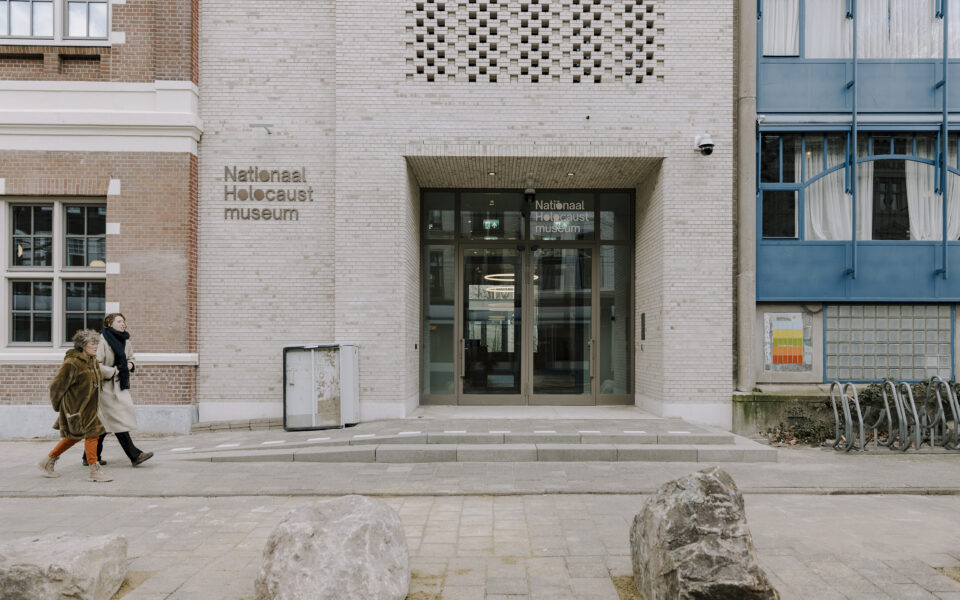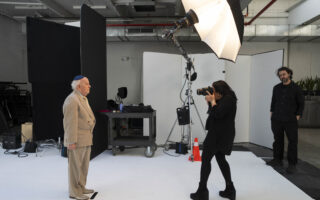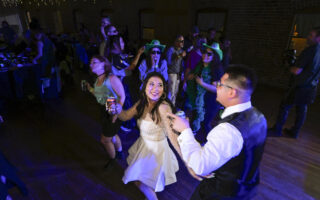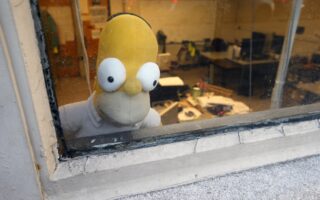With a new Holocaust museum, the Netherlands faces its past

AMSTERDAM – Three faces stare blankly from sepia-toned passport photos, haphazardly pasted onto a card to an unknown recipient. They are probably two parents and their son, but we’ll never know for sure. Under their pictures are the handwritten words: “Don’t forget us!”
It’s unclear when this card was sent. But its plea has helped shape the permanent collection at the National Holocaust Museum in Amsterdam, which opens to the public next week. The new institution has been in the works for almost 20 years, during which time the project overcame persistent skepticism partly driven by hesitance at facing this part of Dutch history.
“I think it’s a remnant of a long-felt discomfort in the Netherlands with taking ownership of what happened,” said Emile Schrijver, the general director of the National Holocaust Museum.
While other museums in the Netherlands cover aspects of the history of the Holocaust – such as the Anne Frank House, or museums that focus on World War II more broadly – the National Holocaust Museum is the first institution devoted to telling the full story of the persecution of Jews in the Netherlands.
“The collective embrace of the fact that the fate of the Jews in the Second World War differed substantially from the fate of the Netherlands, that took a very long time,” Schrijver said. The opening of the museum, Schrijver said, “is a kind of closure to a process of acceptance.”
In the Netherlands, the Nazis deported 75% of the country’s Jewish population to concentration camps, the highest such percentage in Western Europe. The new museum aims to answer the question of how such a large group of people – 102,000 Jews, but also 220 Romani people, also known as Roma and Sinti – could be removed from their daily lives, and what those lives looked like before and, if they survived, after the war.
Part of the answer lies in the brutal bureaucracy installed by the Nazis during their occupation and carried out by Dutch civilians and officials. On the second floor of the museum, an overwhelming stream of words depicting laws against Dutch Jews is printed on the walls, inescapable and overwhelming.
Examples jump out at visitors, whether they plan to read them or not. November 11, 1941: Jews are no longer allowed to attend tennis, dance or bridge clubs. June 11, 1942: Jews can no longer shop at fish markets. June 12, 1942: Jews must hand in their bicycles. September 15, 1942: Jewish students are barred from universities.
Walking past, “you feel the oppression and the dismantling of the rule of law and freedom for every Jew,” said Annemiek Gringold, the museum’s head curator. “That crime, no matter how neatly captured in judicial text, is always present.”
In the museum’s galleries, the lives of Dutch Jews are examined in displays including clothing, jewelry, suitcases and other items. The intention, Gringold said, was to portray people as full-fledged individuals, rather than solely as victims.
“That’s the only way to do justice to someone’s memory,” Gringold said. “Otherwise someone is reduced to what the Nazis made them into. We don’t want that.”
Reckoning with history has slowly become part of Dutch society, including through apologies from the government and the royal family for the Holocaust as well as the country’s role in the slave trade.
Gringold said she first proposed opening a national Holocaust museum in 2005, but, at the time, many questioned whether such a museum was necessary. Since 2015, the Jewish Cultural Quarter, the organization that runs the museum, has hosted temporary exhibitions in the space that is now the museum. But pop-up exhibitions were not enough to tell the entire story, the museum’s leaders said. The Jewish Cultural Quarter bought the building in 2021, and started renovations to turn it into a space to present a permanent collection.
The building – a former school – stands across the street from a theater that the Nazis turned into a major deportation center, and next to a day care where Jewish children were held before they were sent to concentration camps.
The museum interiors, which were redeveloped by Amsterdam-based architects Office Winhov, are lit by natural light, filtered through soft gray blinds. This intentionally refers to how the Nazis committed their atrocities in broad daylight, for everyone to see.
Architect and artist Daniel Libeskind, who was not involved in this project, but who has designed several major Holocaust memorials or museums, including in Berlin and Amsterdam, said that throughout his career, he had also faced skepticism. For a long time after the war, it was hard for people to face the shadows of their past, Libeskind said, and the creation of remembrance institutions was left to later generations.
Dutch Holocaust survivors said the opening of the museum was an important milestone.
“I teach in schools about World War II, and I always hear how little time is spent on the Holocaust,” said Salo Muller, who survived the war by going into hiding as a 6-year-old in 1942. He had been separated from his parents after a Nazi raid, and was taken to the day care next to the museum, but resistance fighters helped him escape. He never saw his parents again.
After a recent private visit to the museum before its public opening, Muller said he felt very emotional. “When I walk around there, so many things are going through my head,” he said. “My family was here, and was deported. My parents, my grandparents, my uncles and cousins. It really touches me.”
At the very end of the collection, which also includes video testimonies by survivors as well as pictures and videos from extermination camps, visitors finally encounter those passport photos of the three anonymous people who asked to not be forgotten, but whose names were lost to history regardless.
The museum used that imperative – “remember us!” – as part of its own message, said Gringold, the curator. By the time a visitor faces these three individuals, it’s almost impossible not to remember.
“You can no longer say you didn’t know,” Gringold said. “Now you know.”
This article originally appeared in The New York Times.






